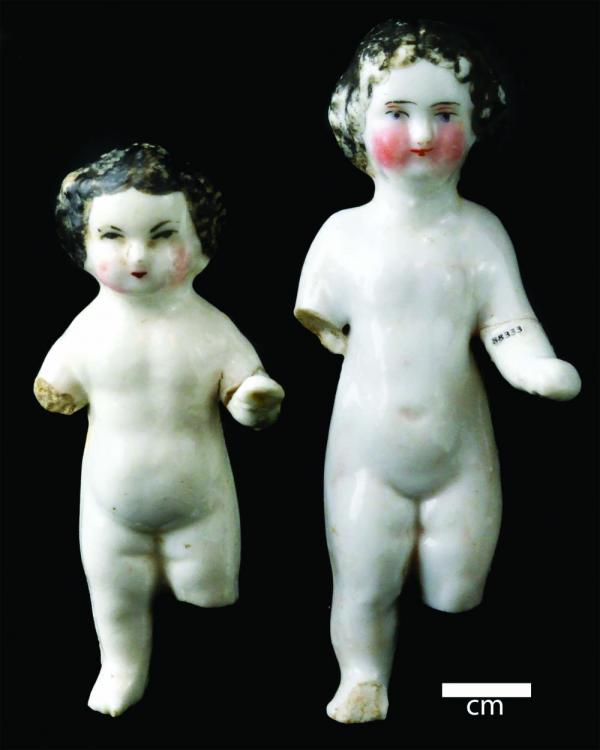May 3, 2018

Two porcelain Frozen Charlotte dolls from the archaelogical dig.
Launch set for Commonwealth Museum on Thurs., May 10
An exhibit laying out the results of a city-led excavation that began two years ago at the site of a historic structure at 232 Centre Street in Dorchester’s St. Mark’s parish will be launched at a reception at the Massachusetts State Archives and Commonwealth Museum at Columbia Point on Thurs., May 10, from 4:30 p.m. to 6:30 p.m.
Entitled “An Extraordinary Look into Ordinary Lives: Uncovering Dorchester’s Industrial School for Girls,” the exhibit will feature the story of the archaeological digs at the property that yielded more than 17,000 artifacts, some 60 of which were selected for the exhibit display.
The find uncovered toy dolls, teacups, and other personal items left behind from the years between 1859 and 1880 when the girls’ school was in operation there. Few historical records of the school and its occupants exist, leaving scholars and historians to piece together stories from what was salvaged from the site.
The exhibit’s curator, Sarah Black, a graduate student at UMass Boston pursuing her master’s degree with a concentration in public history, says she hopes everyone can learn from the exhibit and its heretofore untold stories of 19th century youths left to live and work at such an institution.
“Our hope is to give everyone who comes to the exhibit something to connect with,” she said in an interview with the Reporter. “The exhibits touch on illness in 19th century, what girls at the school were doing in their free time, race relations; there’s something for everyone.”
Founded just before the onset of the Civil War, the school was designed to “prevent evil” in young, disadvantaged girls. A mission statement stated its purpose: To “train these children to good personal habits; to instruct them in household labor; and to exert a moral influence and discipline over them which should fit them to be able and efficient in domestic service, or in any probable mode of gaining their own livelihood.”
As Black noted, the school’s benefactory and educational aims, however noble, may have been compromised by its more practical purpose: training girls as domestic servants. “A part of it was definitely shaping them into obedient, happy little servant girls,” she said. “So you know, is this charity or control?”
A typical day at the school tasked girls with cooking, cleaning, and long hours of sewing, along with some free time. The student body comprised what Black called “some of the most elusive characters in the historical record” – lower class girls, many of whom were orphaned or whose parents were alcoholics or otherwise absent.
For Black, investigating the lives of these average, overlooked girls lent special importance to the work. “I think everyone gets really excited about the big names and the big events. You know, George Washington, Abraham Lincoln, the Civil War, and that’s all well and good, but we aren’t all George Washingtons or Abraham Lincolns. I think telling a story like this helps people connect with the subjects, and it becomes a really relatable narrative.”
Black said that she pieced together one of her favorite stories from records that painted a portrait of a 16-year-old girl at the school who had been illicitly keeping company with an 18-year-old enlisted Union soldier. The narrative emerged from a Civil War ID tag found in the privy. Black and her peers were left to connect the dots from that one clue, and they eventually traced the barely legible name on the pin, James Lannigan, to his female companion.
“It was fun, I felt like a detective throughout this entire process,” said Black. “Every time you find something, it’s so exciting that it makes you want to keep looking for more.”
Analyses of artifacts found in the privy by the City Archaeology Program and scans of admissions records and secretary notes revealed other small acts of rebellion: pipe stems, for instance, or broken glass from bottles of alcohol. Black was laughing as she talked about discovering similarities between today’s adolescents and those who lived centuries ago.
“You can almost envision them gathering together late at night and partaking in certain vices,” she said. “They’re teenage girls, so what do you expect?”
The exhibit opening will be free and open to the public. It will remain on display through August of this year.


